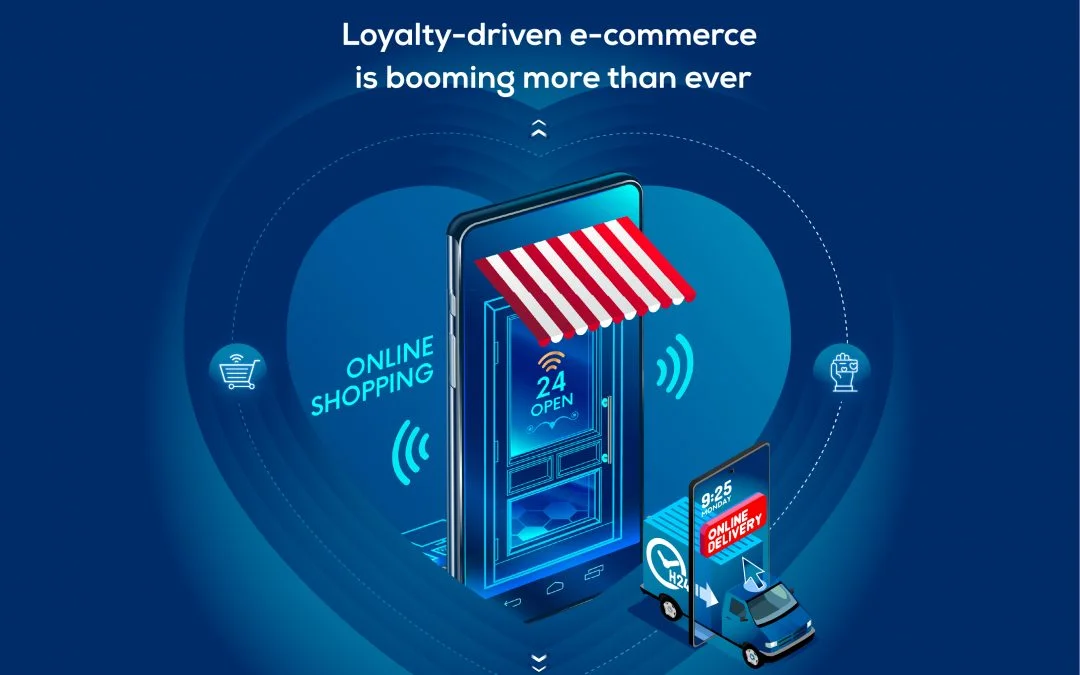- Design industry shaping loyalty programs
- Integrate easily and go live quicker
- Deliver hyper-personalized consumer experiences
Blue Rewards from Al Futtaim Group Shares Loyalty Success Stories and Evolution. Watch Podcast >
Capillary Announces 2nd Annual Captivate 2025 Summit: Transforming Loyalty Management with New AI Tech Read more >

With global sales set to hit $6 trillion by 2022, the ecommerce industry is a juggernaut that shows no signs of slowing down.
While it presents a massive opportunity for retailers, the industry has been characterized by rapid transformation in terms of product innovations, new channels and augmentation of emerging technologies.
To stay ahead and win the sector, retailers will need to :
With this report, we aim to uncover the technological and customer trends that are likely to make the biggest impact on ecommerce in 2020 and beyond. To offer you a truer perspective, we have listed four attributes for each of the trend based on their predicted :
Traditional monolithic commerce frameworks served well for desktop-based commerce. But newer engagement and commerce channels like voice assistants, wearables, PWAs and IoT-based devices like Amazon Dash, exposed the limitations of these straightjacketed frameworks when it comes to supporting new customer experiences, business models and ecosystem partners.
With User Experience and customer journeys gaining greater prominence, several enterprise brands are expected to migrate to an API-based, headless commerce framework to decouple the front end visual layer from the back end core commerce functionalities to seamlessly integrate new capabilities and systems.
Key Takeaway for Brands: Headless commerce solutions offer several benefits like faster time to market, greater security, easy integrations and superior customer experience. If you’re still stuck with a legacy ecommerce platform, this might be the best time to migrate to a cloud-based headless commerce solution.
While the initial ecommerce momentum was spurred by books, fashion/apparel and electronics, the next phase of growth – especially in emerging economies in Asia and the Middle East – is expected to be fueled by hyperlocal-based SKUs like grocery, personal care, beauty services, food and FMCG product sets. And for a good reason – Asian consumers prefer to shop at their local neighbourhood stores, due to multiple factors, mostly related to trust and emotional reasons.
For instance, in India, 96% of the commerce still happens at mom and pop stores and in the coming years, India and China are poised for explosive growth in the hyperlocal space. Several hyperlocal startups (BigBasket, Zopper, Swiggy, Dunzo) along with ecommerce giants like Amazon and Flipkart are investing heavily in logistics and mobile technology to capture this massive opportunity.
Key Takeaway for Brands: While hyperlocal platforms can get you the initial eyeballs and sales, it will be prudent to start investing in your own ordering platform and logistics to ensure long term customer loyalty.
Mobile Commerce or mcommerce is merely a natural subset ecommerce. However, it’s turning out to be a significant extension with the potential to outgrow its parent in terms of sales, engagement levels and conversions.
By 2021, mobile ecommerce sales are expected to account for 54% of total ecommerce sales, accounting for a staggering $659 billion in sales. And this year, conversion rates on mobile is expected to outpace desktop on Black Friday.
Here are the major mcommerce trends and innovations that will gain traction in 2020 and beyond :
Key Takeaway for Brands: Brands and retailers will need to invest in mobile-first ecommerce platforms and PWAs to improve responsiveness, page load times and overall user experience. Chinese ecommerce giant Aliexpress saw a conversion rate increase of 104% by deploying their PWA. Additionally, brands will need to start considering their msite and mobile app as key components in their omnichannel strategy.
Longevity : ⧫⧫⧫⧫⧫
Scale of Adoption : ⧫⧫⧫⧫
Business Impact : ⧫⧫⧫⧫⧫
Customer Experience Impact : ⧫⧫⧫⧫⧫
What made Amazon the successful ecommerce giant it is today? One of the best loyalty programs? Superior logistics? Obsessive-levels of customer service? Maybe all of the above. But one thing that has helped Amazon gain a competitive edge above other ecommerce businesses is their ability to leverage AI and other cutting-edge technologies to enhance and improve all aspects of their business. From using Natural Language Processing to power Alexa to leveraging Collaborative Filtering to personalize recommendations and enhancing its logistics using predictive rerouting, Amazon has managed to expand the use cases for AI and ML. As computing power gets cheaper (Moore’s Law), and advancements in GPU technologies enables processing of complex neural queries, expect AI and ML adoption and applications to grow exponentially in the coming years.
Here are top expected applications of AI in Ecommerce :
Key Takeaway for Brands : Investment in emerging technologies can be daunting but take the opportunity to evaluate and analyze the business and customer benefits of these technologies and try to implement them in a staged manner. The User Experience and Customer Engagement is a great place to start.
Longevity : ⧫⧫⧫⧫
Scale of Adoption : ⧫⧫⧫⧫⧫
Business Impact : ⧫⧫⧫⧫
Customer Experience Impact : ⧫⧫⧫⧫
For several years, omnichannel synced various digital and physical channels to deliver a seamless customer experience. However, omnichannel wasn’t without its share of limitations. In fact, 78% of retailers admitted that they were not successful in enabling a true omnichannel experience due to limitations in data sharing and real-time, personalized engagement.
This is where ‘Unified Commerce’ gains an advantage over Omnichannel. In essence, Unified Commerce is an advanced form of Omnichannel Commerce which essentially negates a lot of the limitations of the latter. For instance, rather than connecting multiple channels and platforms, you deploy a single, centralized platform that serves as a universal truth. With this, you can deliver a personalized and seamless customer experience every time, regardless of the channel.
Key Takeaway for Brands : Centralize data and transactions on a unified platform to get a single source of truth. Invest in API-driven ecommerce platforms to integrate and connect apps, channels and devices.
Longevity : ⧫⧫⧫⧫
Scale of Adoption : ⧫⧫⧫⧫
Business Impact : ⧫⧫⧫⧫⧫
Customer Experience Impact : ⧫⧫⧫⧫⧫
Social commerce has been slowly gathering momentum in the last few years, and 2020 is expected to be its ‘flywheel’ moment. It’s a great way for brands to acquire more customers at a lesser cost besides simplifying the purchase journey. In the coming years, it’s expected to become the third major sales channel, taking its place alongside ecommerce and traditional retail.
The percentage of brands in the US that use social media as an ecommerce sales channel nearly doubled in a year’s time—from 17% in 2017 to 33% in 2018.
The major factors that will fuel its rise are spike in video/visual content, Progressive Web Applications, cheaper data, greater smartphone penetration, improvement in user experience in terms of native checkouts and payment security and the continually increasing amount of time spent by millennials and the younger generations, on social media apps.
Longevity : ⧫⧫⧫
Scale of Adoption : ⧫⧫
Business Impact : ⧫⧫⧫
Customer Experience Impact : ⧫⧫⧫⧫⧫
Payment innovations like digital wallets, in-app purchasing, peer-to-peer lending and new payment models like Venmo and even Facebook cash were significant factors that contributed to the rapid growth of ecommerce.
Paypal paved the way for cross-border ecommerce by enabling ecommerce brands to reach a wider customer base through global transactions. From then on, companies like Payoneer and Stripe have followed the footsteps of PayPal but discovered their potential products and business models. For instance, Payoneer lets users pull funds from cancellations/returns to their card without the wait, unlike PayPal. This is a huge advantage for ecommerce shoppers, plus it’s much more accessible in developing countries.
Another fintech company, Paysera offers its users payment services, easy currency conversion, and seamless checkout services for e-commerce companies, thereby removing many of the barriers towards success for e-commerce businesses. Yet another fintech innovation that has seen a lot of buzz of late is the cashierless payment system with a host of startups like Caper, Standard Cognition and Trigo Vision already launching a working prototype.
The innovations in payment and fintech is showing no signs of slowing down, and therefore its likely to further fuel the evolution of the ecommerce industry.
Longevity : ⧫⧫⧫⧫
Scale of Adoption : ⧫⧫
Business Impact : ⧫⧫⧫
Customer Experience Impact : ⧫⧫⧫⧫⧫
Cross-border commerce has gained significant momentum in the last few years primarily due to the rise of distributed commerce channels like social commerce and conversational commerce.
The phenomenon is likely to have the biggest traction in China and the Middle East. In China, TMall Global has emerged as the biggest cross-border commerce engine with hundreds of US and European merchants setting up storefront marketplaces. The platform doesn’t require the seller to have a legal entity in China which is a major advantage for retailers. In the Middle East, Namshi, Souq and The Modist are the biggest cross-border commerce platforms. Amongst these, Souq requires an in-country partner to show the support documents that allow selling in each specific country. The emergence of a high-spending, brand-conscious consumers in parts of Asia and the Middle East is further expected to fuel cross-border commerce in the coming years.
Key Takeaway for Brands : Cross-border ecommerce is here to stay and brands will need to evaluate it as a growth strategy for an ecommerce business. It needs significant investments in payment processing, staffing and logistics, and therefore should be done in a phased manner for maximum effectiveness.
Longevity : ⧫⧫⧫⧫
Scale of Adoption : ⧫⧫⧫
Business Impact : ⧫⧫⧫⧫
Customer Experience Impact : ⧫⧫⧫
The proliferation of dark stores is a direct consequence of two factors: the rise of hyperlocal commerce and the rapid growth of the online grocery market. In fact, the surge in online grocery sales and dark store penetration share a symbiotic growth relationship; with each of them fueling the growth of the other.
Dark stores are essentially retail distribution centers that resemble a typical supermarket but is used primarily to fulfill online orders. While the concept started out as a way to fulfill grocery orders, several brands are testing out the dark store concept for apparel and food deliveries.
For several brands, dark stores have become strategically important in matching the ever-shrinking shipping time and superior customer service levels of major etailers like Amazon, Alibaba and Souq. They also fuel the growth of cross-border commerce by making it easier for retailers to expand their operations into new regions and markets.
Key Takeaway for Brands : Supermarket and F&B brands should consider leveraging dark stores in their fulfilment strategy. It can offer several benefits like higher capacity, increased efficiency, wider product assortment, centralized routing, faster shipping etc.
Longevity : ⧫⧫⧫⧫
Scale of Adoption : ⧫⧫⧫
Business Impact : ⧫⧫⧫⧫
Customer Experience Impact : ⧫⧫⧫⧫
As more brands realize the benefits and advantages of physical and digital retailing, expect the divide to further break down in the coming years. Once pegged as rivals, ecommerce & brick and mortar stores will become closely intertwined to create a collaborative, integrated and interconnected retailing. The last few years saw traditional retailers adopt innovations and best practice from ecommerce counterparts like interactive websites, PWAs, and mobile point-of-sale solutions.
Going forward, expect the migration of advanced ecommerce innovations into the brick and mortar realm like highly personalized recommendations and customer engagement using AI-powered computer vision technologies and staff enablement apps, Endless Aisle solutions and smarter fulfilment/inventory management technologies.
On the other side, pure play ecommerce brands are expected to continue their offline expansion in the form of pop up stores, experience centers, dark stores and other O2O innovations like order-online-pickup in-store.
Key Takeaway for Brands : Pick a focus area (eg:- staff enablement, customer engagement, store insights, fulfilment etc.). Explore the solutions, start slow and analyze the results before scaling into full-fledged deployment.
Longevity : ⧫⧫⧫⧫⧫
Scale of Adoption : ⧫⧫⧫⧫⧫
Business Impact : ⧫⧫⧫⧫⧫
Customer Experience Impact : ⧫⧫⧫⧫⧫

May 22, 2018 | 4 Min Read
When Flipkart and Amazon hit the Indian market, brick and mo

July 25, 2014 | 4 Min Read
Smartphones are increasingly becoming an essential part of t

June 23, 2022 | 4 Min Read
If there were any questions about whether e-commerce is here